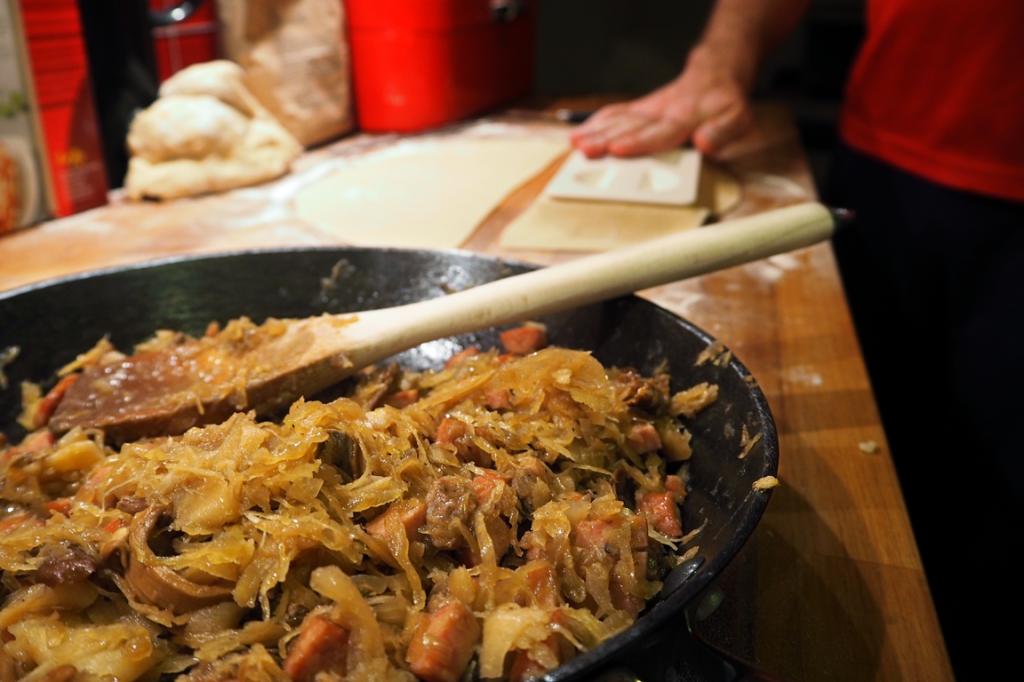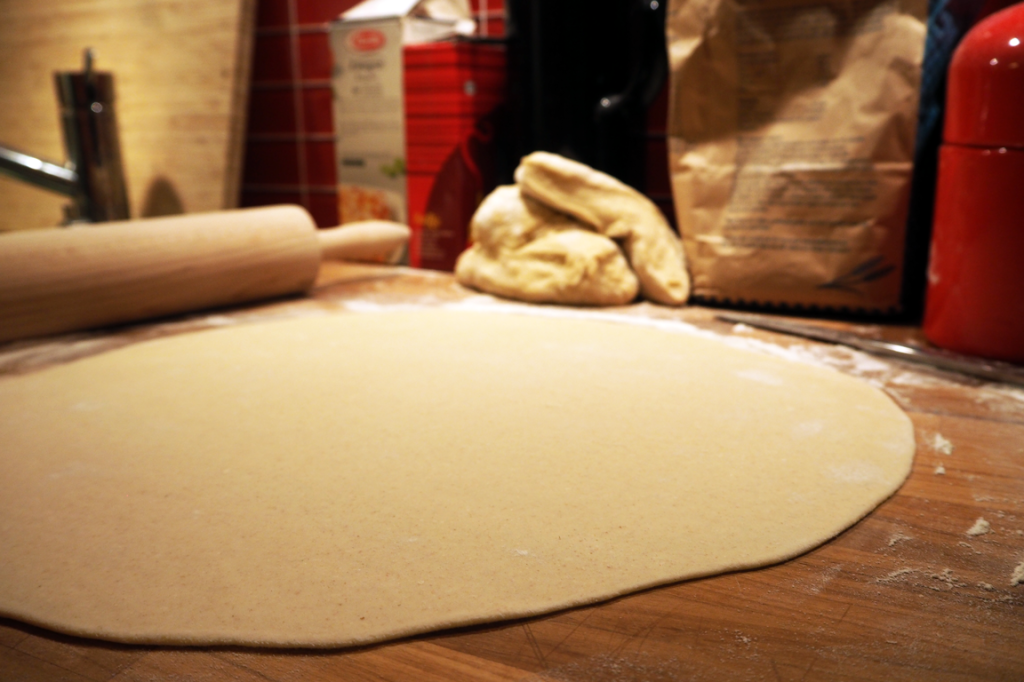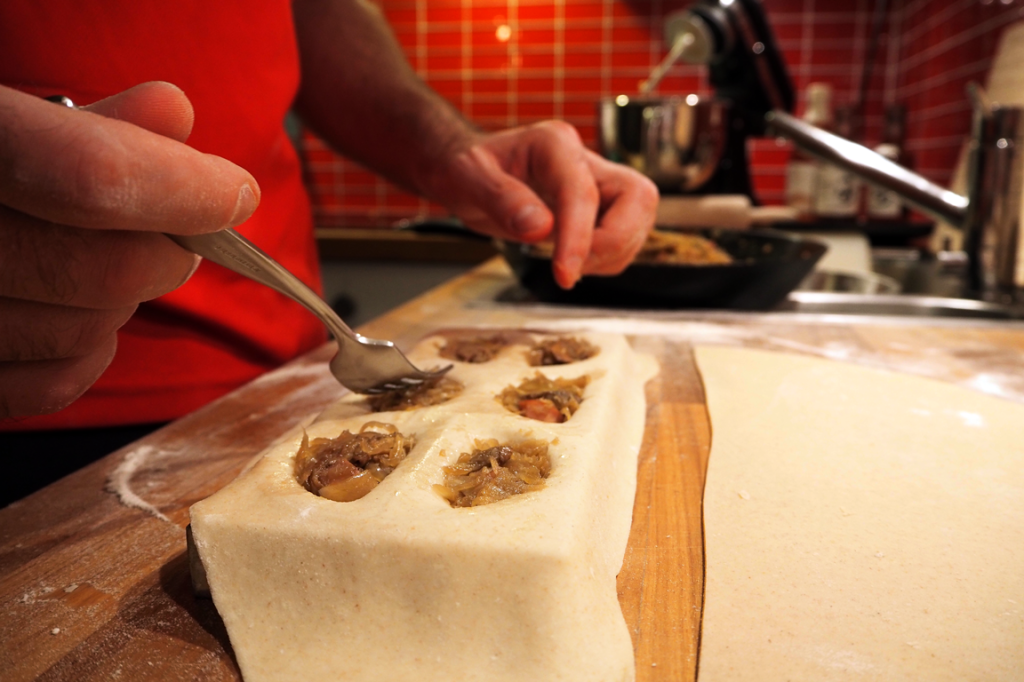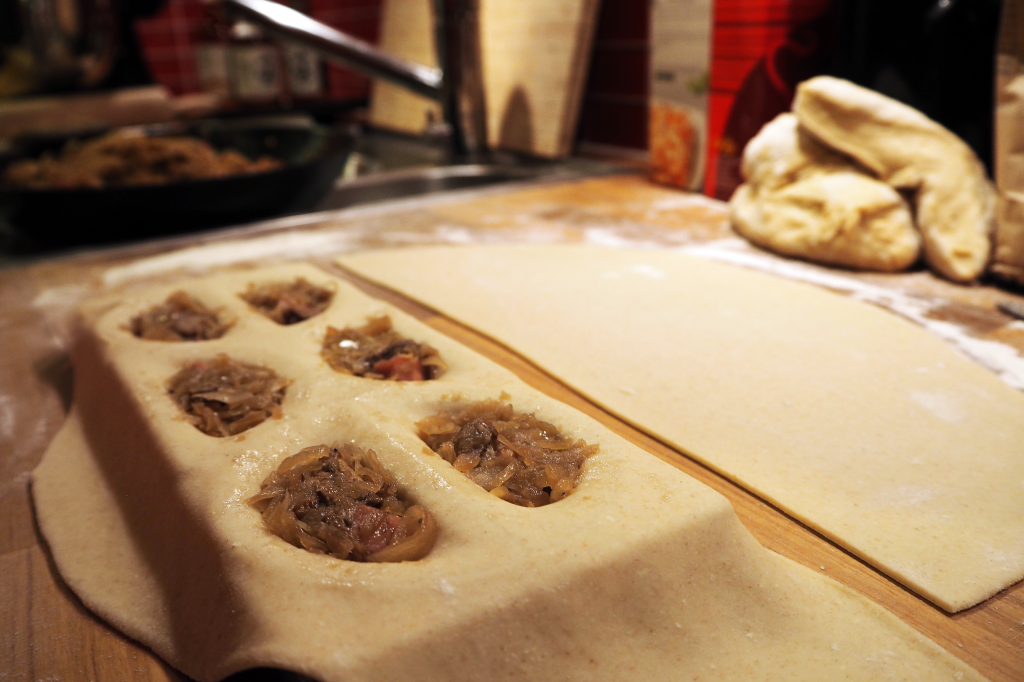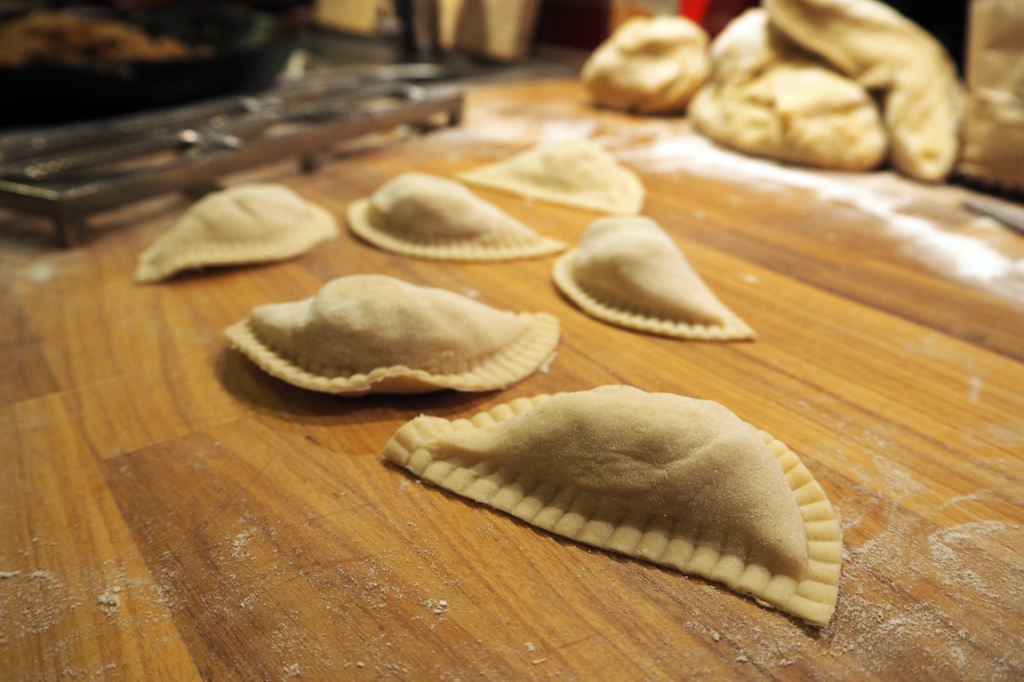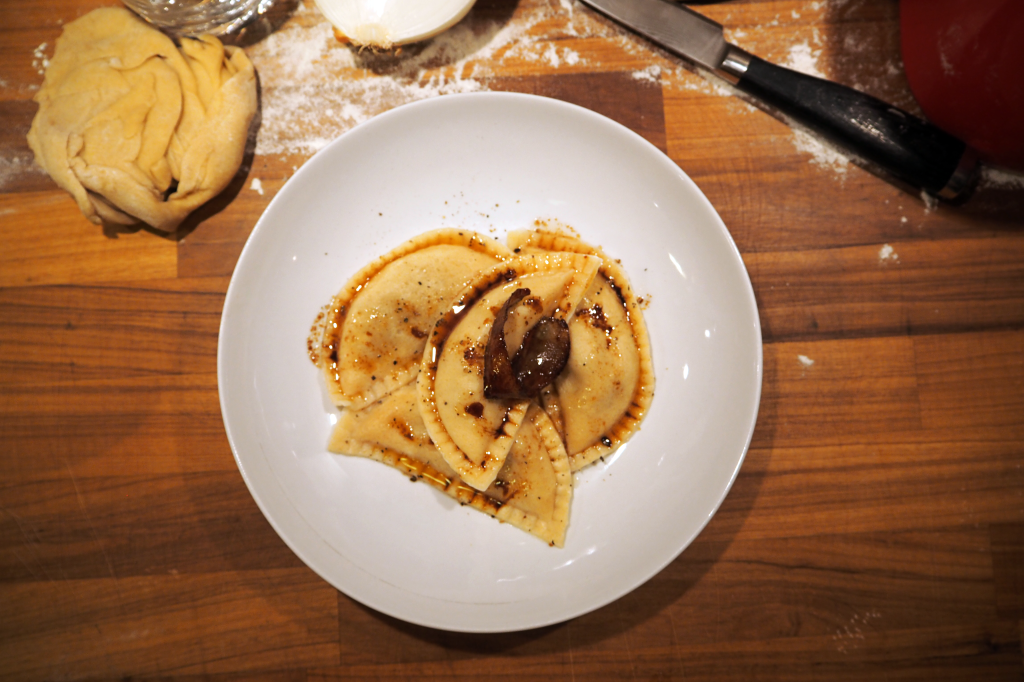Pierogi with parsnip
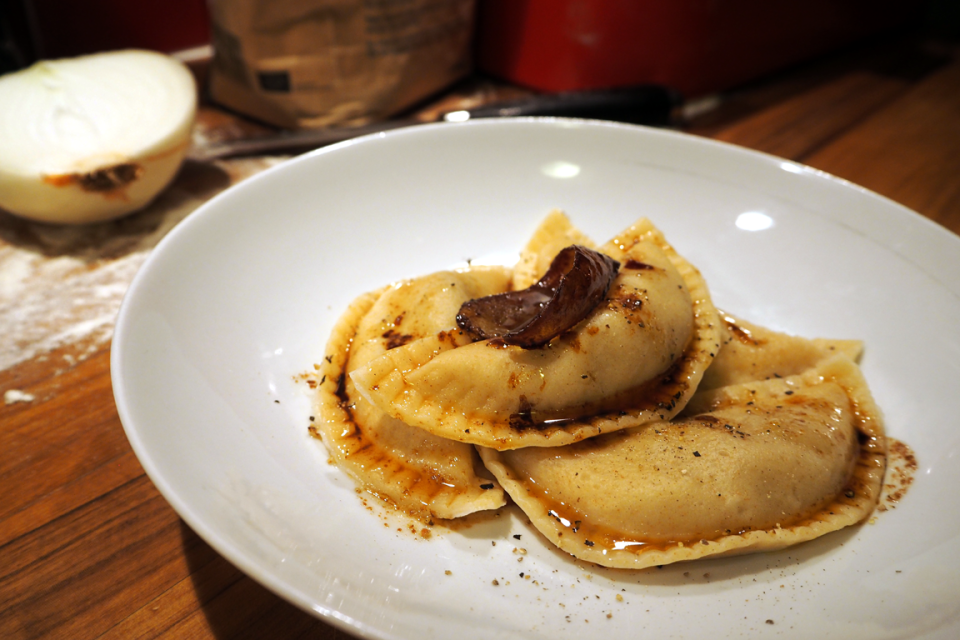
Pierogi, or the juvenile diminutive form pierożki, are Polish dumplings of unleavened dough first boiled and then usually baked or fried. They’re traditionally stuffed with a potato filling, sauerkraut, ground meat or cheese. When stuffed with a potato filling, the Poles call them “ruskie pierogi” (Russian pierogis). When served as a desert, the dumplings are filled with fruits and/or a quark like cheese called biały ser (litterary “white cheese”), sometimes covered in sour cream. They are absolutely wonderful, and today I’ll do my take on them.
There are three things that make my variation different from the traditional ones. First of all, I will be using some baking powder in the dough. As I mentioned above, the dough is traditionally unleavened, but I’ve noticed that a little baking powder gives the pierogi a nice texture. Second, the filling will be based on parsnip. Parsnip is not traditionally used in pierogi fillings, but it’s a very underrated root vegetable with an absolutely wonderful sweet flavor when fried. Third thing I’ll be doing differently, is not frying the pierogi after boiling them. Usually the savory ones are fried, while the sweet ones are not. I like the texture of boiled pierogi if the dough is well prepared. I like fried ones too. Try both, and follow your taste buds command.
This is what you need for the filling
- 1 large parsnip (mine was about 250 grams including the stem)
- 1/2 large onion
- 1 cup of sauerkraut
- 30 grams of dried Scaly Wood Mushrooms or Blushing Wood Mushrooms, or any mushrooms you can get a hold of. If you haven’t dried any mushrooms yet, but only have fresh ones, put them in a dry pan and turn up to medium heat, and make sure to get rid of the liquid. Then use them.
- 250 grams of Polish Krakow style sausage (it’s a semi-dry sausage with an intense flavor and wonderful texture)
- 2 allspice corns
- A glass of water (not important how much, it’s going to evaporate anyway)
- Salt to taste
- Cold pressed rapeseed oil (not the cheap stuff, industrially extracted with the help of chemicals. Buy a quality one, it’s as healthy as olive oil, but unique in it’s flavor)
This is what you need for the dough
- 3 eggs
- 240 grams of yoghurt (about 8 fluid ounces)
- 500 grams of flour (about 4 cups)
- 1,5 grams of salt (three pinches or so)
- 15 grams of baking powder (that’s about 1 tablespoon)
This is what you need to make pierogi
- Butter
- Balsamic vinegar
- Fleshly ground black pepper (yes, freshly ground, because it tastes better!)
Yields a lot of portions, about 40 pierogi. With the size I’m making, about 6 pierogi per person is about enough. But they’re excellent to freeze!
This is how you prepare the pierogi
The pierogi filling
- Peel the parsnip, then use the peeler to cut thin slices of it. When you see the stem, stop. Cut it in thin slices with a knife, and you’ll have thin parsnip flakes.
- Finely mince the onion.
- Fry the parsnip and onion in fine rapeseed oil on medium heat. Be careful, parsnip easily burns.
- Chop up the sausage in fine pieces, and put it in there together with the softening onion and parsnip mix.
- Add the sour cabbage, the dry mushrooms, the allspice and water. The reason I’m using dried mushrooms is because I picked them during season, and drying mushrooms is an excellent way of preserving them. But it’s also easier to handle when cooking.
- Let the filling slowly simmer, and fold every now and then. When the liquid is gone, and it all has a nice brownish color, it’s done. Let it cool a little. Meanwhile, make the dough.
The pierogi dough
- Mix eggs and yoghurt.
- Mix flour, salt and baking powder, and sift it into the egg and yoghurt mix.
- Mix it all up and then kneed the dough, either by hand (about 15 minutes) or in a stand mixer for about 8 minutes.
- Flour a surface, cut the dough in about 4 pieces, and flatten them. I use a pierogi mold that really speeds things up, but you can of course cut out your pierogi using a glass, put some filling in them, and close them using a fork.
- Bring a lot of water to boil, salt it, and boil the pierogi for about 4 minutes. Some recipes say they’re ready when they float, but that’s not really true. Test-boil one first, and try it. When you know the cooking time for the particular size and thickness of your pierogi, put in the rest and boil until ready.
Time to serve!
It’s time for the serving part.
- Melt butter in a pan until it’s brown and has a wonderful nutty flavor.
- (If you want to fry your pierogi after boiling them, do it now, before adding the vinegar. Fry the pierogi in the butter until they get some color and then you add the vinegar.)
- Then pour in balsamic vinegar. Not very Polish, right? But it’s really good.
- Put some thinly sliced parsnip in the butter mix, and let soften for about two minutes. I’ll be using the parsnip as decoration.
- Place the freshly boiled pierogi on a plate, and pour the nutty and tart butter mix over it.
- Garnish with the parsnip, and then sprinkle some freshly ground pepper on top.
Enjoy this variation of a wonderful Polish dish!

